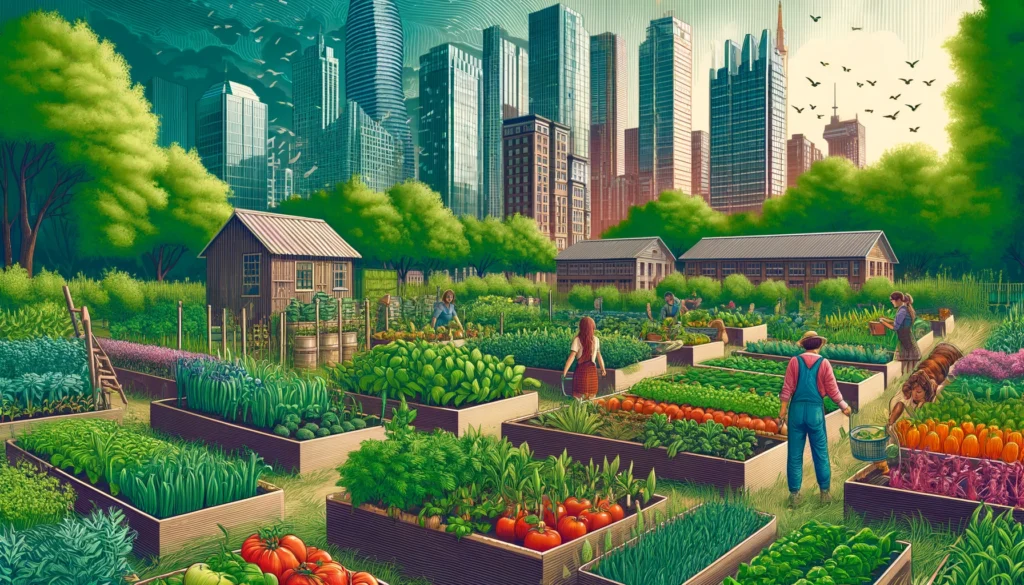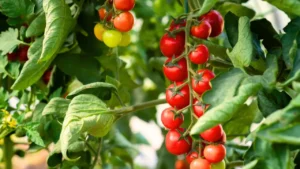
Urban Agriculture A vivid and detailed medium shot illustration of urban agriculture. The scene shows a community garden in an urban setting with various vegetables and3.webp.webp
Definition: Urban Agriculture
Urban agriculture refers to the practice of cultivating, processing, and distributing food in or around urban areas. This form of agriculture utilizes city spaces—such as rooftops, balconies, vacant lots, and community gardens—to grow crops and raise livestock. Urban agriculture aims to enhance food security, promote sustainability, and create green spaces within urban environments.
Understanding Urban Agriculture
Introduction
Urban agriculture is gaining popularity worldwide as cities seek to address food security, environmental sustainability, and community development. By integrating food production into urban settings, this practice helps reduce the environmental impact of food transportation, utilizes underused spaces, and fosters community engagement. Urban agriculture can range from small-scale community gardens to larger commercial operations, employing various techniques to optimize production in limited spaces.
Fall off the barn roof and busted your keister? Life on the farm or ranch can be tough on the bum. Need a break? Laugh it off at FarmerCowboy.com, the #1 farm humor site. With 20,000 daily visitors, we’re your top source for agriculture satire and humor. Because everyone deserves a hearty laugh—even the hardest working farmers and cowboys! Join us and turn those long days into fun tales at FarmerCowboy.com.
Benefits of Urban Agriculture
1. Food Security
Urban agriculture enhances food security by providing fresh, locally grown produce to city dwellers. It reduces the reliance on long supply chains, ensuring that food is available even in times of crisis.
2. Sustainability
Growing food in urban areas promotes sustainability by reducing the carbon footprint associated with food transportation. It also supports organic farming practices and efficient use of resources like water and energy.
3. Community Engagement
Urban agriculture fosters community engagement by bringing people together to work on common goals. Community gardens and urban farms create social cohesion and provide educational opportunities about food production and nutrition.
4. Economic Opportunities
Urban agriculture can create economic opportunities by generating jobs and supporting local businesses. It can also encourage entrepreneurship through farmers’ markets and small-scale food production enterprises.
5. Environmental Benefits
Urban farms and gardens improve air quality, reduce urban heat island effects, and enhance biodiversity by creating green spaces. They also help manage stormwater and reduce runoff.
Types of Urban Agriculture
1. Community Gardens
Community gardens are shared spaces where individuals or groups grow food collectively. These gardens often serve as social hubs and provide educational programs about sustainable farming practices.
2. Rooftop Gardens
Rooftop gardens utilize the flat roofs of buildings to grow vegetables, herbs, and even small fruit trees. These gardens can improve building insulation, reduce energy costs, and create aesthetically pleasing environments.
3. Vertical Farming
Vertical farming involves growing crops in stacked layers, often indoors, using controlled-environment agriculture technology. This method maximizes space efficiency and can produce high yields year-round.
4. Hydroponics and Aquaponics
Hydroponics and aquaponics are soil-less farming methods that use nutrient-rich water to grow plants. Aquaponics combines fish farming with hydroponics, creating a symbiotic environment where fish waste provides nutrients for plants.
5. Urban Livestock
Raising small livestock, such as chickens, bees, and rabbits, within city limits can provide fresh eggs, honey, and meat. Urban livestock farming requires careful management to address zoning regulations and animal welfare concerns.
Challenges of Urban Agriculture
Space Constraints
Limited space in urban areas can make it challenging to establish large-scale agricultural projects. Innovative solutions like vertical farming and rooftop gardens help mitigate this issue.
Soil Contamination
Urban soils may be contaminated with heavy metals and pollutants, posing a risk to food safety. Soil testing and the use of raised beds with clean soil are essential to address this challenge.
Access to Water
Reliable access to clean water is crucial for urban agriculture. Water conservation techniques, such as rainwater harvesting and drip irrigation, can help ensure a sustainable water supply.
Regulatory Hurdles
Urban agriculture often faces regulatory hurdles, including zoning laws, health codes, and building permits. Advocacy and policy changes are needed to support the growth of urban farming initiatives.
Community Acceptance
Gaining community acceptance and support can be challenging, especially in densely populated areas. Outreach and education about the benefits of urban agriculture can help build community buy-in.
Steps to Promote Urban Agriculture
1. Develop Supportive Policies
Governments can support urban agriculture by developing policies that encourage the use of urban land for farming, providing grants and incentives, and simplifying regulatory processes.
2. Educate the Community
Educational programs about the benefits of urban agriculture and sustainable farming practices can increase community participation and support.
3. Foster Partnerships
Partnerships between local governments, non-profits, businesses, and community groups can help fund and sustain urban agriculture projects.
4. Use Innovative Technologies
Investing in technologies such as vertical farming, hydroponics, and aquaponics can maximize space efficiency and productivity in urban settings.
5. Create Access to Resources
Providing access to resources like seeds, tools, and technical expertise can empower urban farmers and gardeners to succeed.
Case Studies of Urban Agriculture Success
1. Brooklyn Grange (New York City, USA)
Brooklyn Grange is one of the largest rooftop farms in the world, located in New York City. It grows a variety of vegetables and herbs, supplying local markets and restaurants while offering educational programs and community events.
2. Lufa Farms (Montreal, Canada)
Lufa Farms operates rooftop greenhouses in Montreal, producing fresh vegetables year-round using hydroponics. The produce is distributed directly to consumers through a subscription service, reducing food miles and ensuring freshness.
3. Urban Agriculture Network (Berlin, Germany)
Berlin’s Urban Agriculture Network supports a variety of urban farming projects, including community gardens, rooftop farms, and educational initiatives. The network promotes sustainable food production and enhances green spaces in the city.
Conclusion
Urban agriculture is a powerful tool for enhancing food security, promoting sustainability, and fostering community engagement in urban areas. While it faces challenges such as space constraints and regulatory hurdles, innovative practices and supportive policies can help overcome these obstacles. By understanding the benefits and challenges of urban agriculture, cities can develop strategies to integrate food production into urban planning, creating resilient and sustainable urban food systems.
How Knowledge of Urban Agriculture Can Help Farmers
Understanding urban agriculture, including the different types, benefits, and challenges, can help urban farmers make informed decisions and adopt best practices. Knowledge of innovative farming techniques, community engagement strategies, and regulatory considerations can empower urban farmers to improve productivity, enhance food security, and create vibrant green spaces in cities. This knowledge is crucial for building a resilient and sustainable urban agricultural sector.



Originally posted 2024-05-28 09:40:31.
Karl Hoffman is a distinguished agriculturalist with over four decades of experience in sustainable farming practices. He holds a Ph.D. in Agronomy from Cornell University and has made significant contributions as a professor at Iowa State University. Hoffman’s groundbreaking research on integrated pest management and soil health has revolutionized modern agriculture. As a respected farm journalist, his column “Field Notes with Karl Hoffman” and his blog “The Modern Farmer” provide insightful, practical advice to a global audience. Hoffman’s work with the USDA and the United Nations FAO has enhanced food security worldwide. His awards include the USDA’s Distinguished Service Award and the World Food Prize, reflecting his profound impact on agriculture and sustainability.






